Supercritical geothermal might need a lot of fracking and earthquake management
Rock ductility at high temperatures may require hydraulic fracturing to generate economic permeability. Long-term circulation for heat mining, will require careful management of induced seismicity.
Supercritical geothermal systems are in the news in New Zealand right now. Our government is planning to invest $60 million for some exploratory drilling of deep wells. There is some very cool science to come, but I think also some major challenges if this is to be turned into a commercial prospect. In this post, I’ll explain why lessons from overseas suggest we could need a lot of hydraulic fracturing to turn supercritical geothermal into a reality. Long-term circulation might also lead to moderate magnitude seismicity. Neither the fracking nor the earthquakes are necessarily a project killer, but planning for them should start early.
What is supercritical geothermal?
At its most basic, the idea is to take very hot water from underground and make electricity. Today’s geothermal power stations use water between 200 and 300°C (up to 320°C in Rotokawa). Supercritical geothermal is more ambitious, hunting for water between 375 and 500°C. The higher the temperature, the more energy there is to extract for electricity generation.
The concept is straightforward, you just keep drilling down until the water gets hot enough. And in New Zealand’s central North Island, things get hot fast, especially if you’re in and around a geothermal system or a shallow magma body. The plan is to drill wells between 3.5 and 6 km, which roughly corresponds to the colourful blobs on the geophysical interpretations that imply some magma nearby. The images below from Bertrand et al. (2022) show some possible magma bodies.
The low resistivity C1 to C4 plumes are therefore interpreted as magmatic intrusions with an overlying lens of exsolved hypersaline fluids that act to localise and concentrate up-flows of convective heat transport in the overlying crust
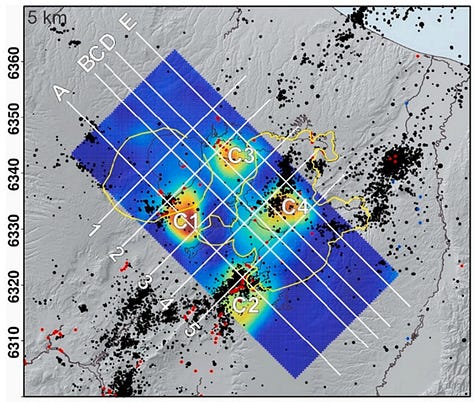
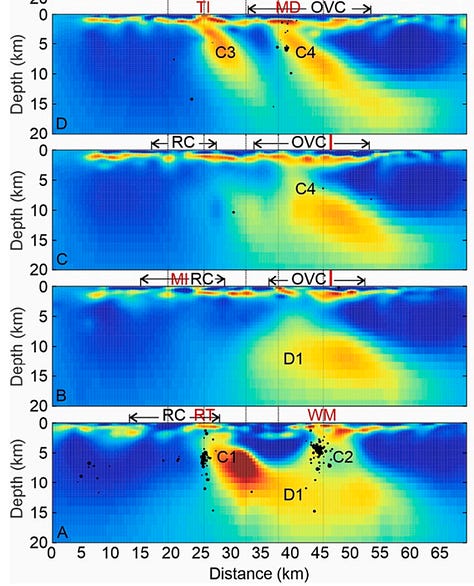
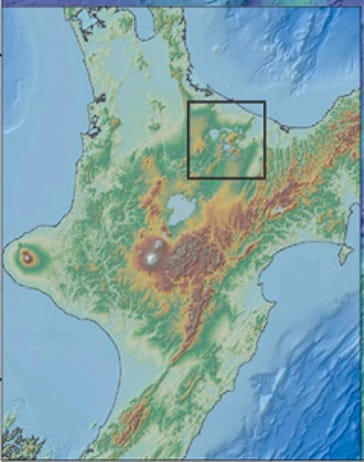
The intention I think is not to go into the magma body itself — which would be cool, but obviously a complication — but rather to exploit the very hot greywacke rock that surrounds it.
The drilling part seems achievable although you’ll probably want some specialised systems for the very high temperatures. A good outcome would be to find a reservoir of supercritical water waiting to be extracted. There are some reasons to think it might not work out that way, in which case a back-up option is prudent. I’ll explain why and what that would be below.
How much supercritical is there?
Scientists at GNS have had a go at estimating NZ’s potential resource using a stored heat calculation. This is probably the best you can do when there’s only limited information about what’s happening between 3 and 6 km depth. They estimated about 30 000 GWh/yr, which is what you’d get from about 3500 MW of power stations. A later report suggested 2000 MW might be more likely. I have included the GNS calculation in the footnotes1 if you’re interested in the detail.
Stored heat is an estimate of how much energy is potentially available in a volume of rock, in this case between 375 and 500°C. It assumes you can get about 4.5% of the heat out, similar to extraction from other geothermal systems. But the calculation itself doesn’t tell you how to get the heat out, only that the energy is there in theory. So while the number seems fair to me, what’s missing is a theory of operation: what is the plan for extracting all that energy?
Supercritical geothermal has been tried before
This is not the first time scientists have drilled for supercritical in a geothermal system. At the Kakkonda geothermal power station in Japan, scientists drilled to 3.5 km depth, finding temperatures of about 500°C at the bottom. They were close to a granite pluton that was cooling down.
Unfortunately, temperature measurements in the Kakkonda well showed that the rock was barren. None of the typical fractures and faults that grant you access to the geothermal water you need for your power plant. Just solid (but superhot!) rock. They estimated the hydrothermal system (from which you could extract water) only went to about 350°C.
In the Larderello geothermal plant in Italy, scientists reported a similar experience exploring for supercritical conditions. Drilling to almost 3 km reached an estimated temperature of 500°C. But the scientists concluded there was no flow of water into the borehole at supercritical conditions. The highest flowing temperatures in the field are about 350°C. Again, wherever supercritical temperatures are found, the rock apparently won’t give up water. This is a problem for supercritical geothermal.
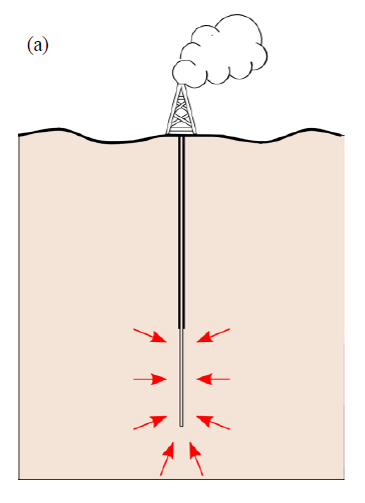
But there is one place that bucks the trend: Iceland. A well drilled in the Krafla geothermal field produced water at 450°C, which is very supercritical. They also drilled into magma a couple times, which I wrote about here. The experience was the similar drilling at Reykjanes (426°C), which tells you this wasn’t a one-off. But the fluids coming up are quite nasty so that corrosion likely poses a long-term threat to your wells. Anyway, high temperatures are very clearly not a barrier to water flowing in Iceland — that’s probably to do with the special rocks they have there.
Rock physics might present a problem for supercritical geothermal
If you’re familiar with the NZ’s attitude to indoor heating, you’ll know that honey is hard like rock in winter but delightfully spreadable in the summer. If you use a chisel on your winter honey, you can usually crack it open and put some flakes on your sandwich. But when the honey heats back up, it starts to flow and any gaps or holes you had dug get filled in. No one’s fault, that’s just the physics of honey. Rock is the same, only it needs to get to supercritical temperatures or higher before it becomes ductile and starts to flow.
For quartzofeldspathic rocks, examples of which include NZ greywacke and granites elsewhere, ductility generally happens between 300 and 450°C. This explains why 500°C wells in Japan and Italy don’t have cracks for water to flow out of — whatever might have created those cracks in the past, ductility had by now closed them up.
But Iceland is clearly different. The rock there is a basalt, which is a volcanic rock with superb CO2 absorbing capacities. It also has a really high temperature at which it goes ductile, maybe as much as 650°C. So it makes sense that they can drill and get 450°C water out of a well — the rocks just hold up better over there.
There have been a couple of recent experimental studies claiming high-temperature granites retain some permeability when ductile — meshes or clouds of microcracks rather than a few big fractures. But the experiments show that this ‘not completely impermeable’ rock still has rather low permeability in the microdarcy range or less. Hardly suggestive of a bountiful resource. And certainly no one told the supercritical rocks at Kakkonda or Larderello that they were supposed to be permeable.
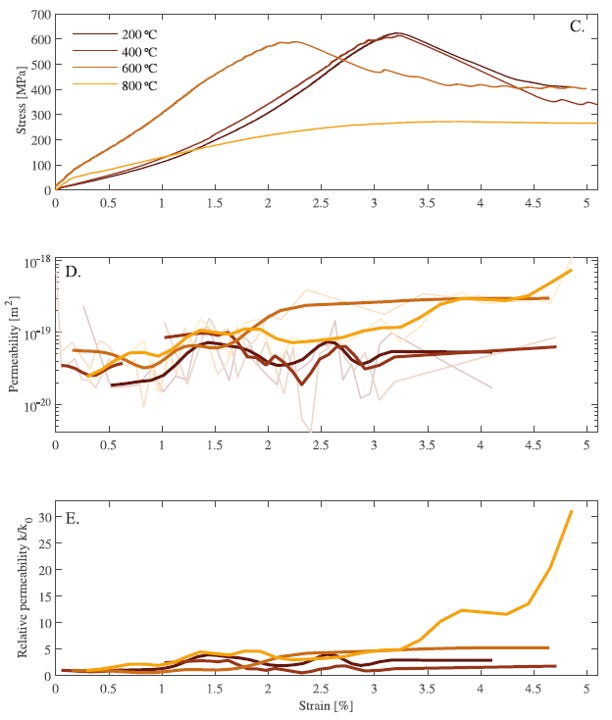
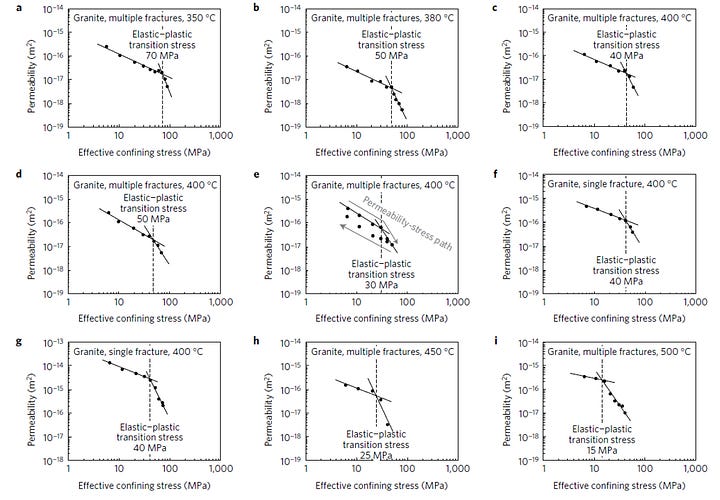
Another explanation is that Icelandic rocks have more permeability because the crust there is rifting — tearing itself apart at rate of 20 mm/yr. This is interesting, because New Zealand’s geothermal fields are also in a rifting region, albeit at half the Icelandic rate (but that’s still very fast!) Fair enough to suggest then that we may have hot, ductile permeability where Japan and Italy don’t simply because our rocks stretch quicker than theirs2.
What this all means is that NZ has potentially two kinds of geothermal rock to contend with. The first kind is hard and brittle, between 2 or 3 km deep and 350°C or less. This rock has lots of cracks and that’s where our geothermal water currently comes from.
The second kind of rock, which is the focus of recent aspirations, is deeper and hotter than 350°C. Overseas experience and decades of laboratory studies point towards this rock being ductile and impermeable. But there is a hypothesis that the rock here is tearing itself apart fast enough to overcome this ductility and that we may have deep permeability after all — this is essentially what the supercritical drilling would test.
Rock physics can be conquered though
But even if drilling for supercritical encounters only ductile and impermeable rock, it’s not all bad news. The inconvenient impermeability of rock has plagued another kind of geothermal system for a long time, but seems recently to have been solved.
The Enhanced Geothermal System is a concept that has been pursued for decades overseas. The idea is to drill into hot rock (but not supercritical hot) that doesn’t have a lot of fractures with flowing water. Then, you just make the permeability yourself by hydraulically fracturing3 the rock with high pressure water.
This was first attempted in New Mexico in the 1970’s and at various other places around the world over the years (e.g., Europe, China, Australia). Success was quite limited though, because drilling and fracturing are expensive and they never really created enough permeability.
But a US company called Fervo Energy seems recently to have cracked the problem using an Oil & Gas approach. They drill long sets of parallel horizontal wells and then using multi-stage fracking to connect them up. This concept works well for developing shale gas resources and apparently also produces low-cost, adequate permeability in hot granite.
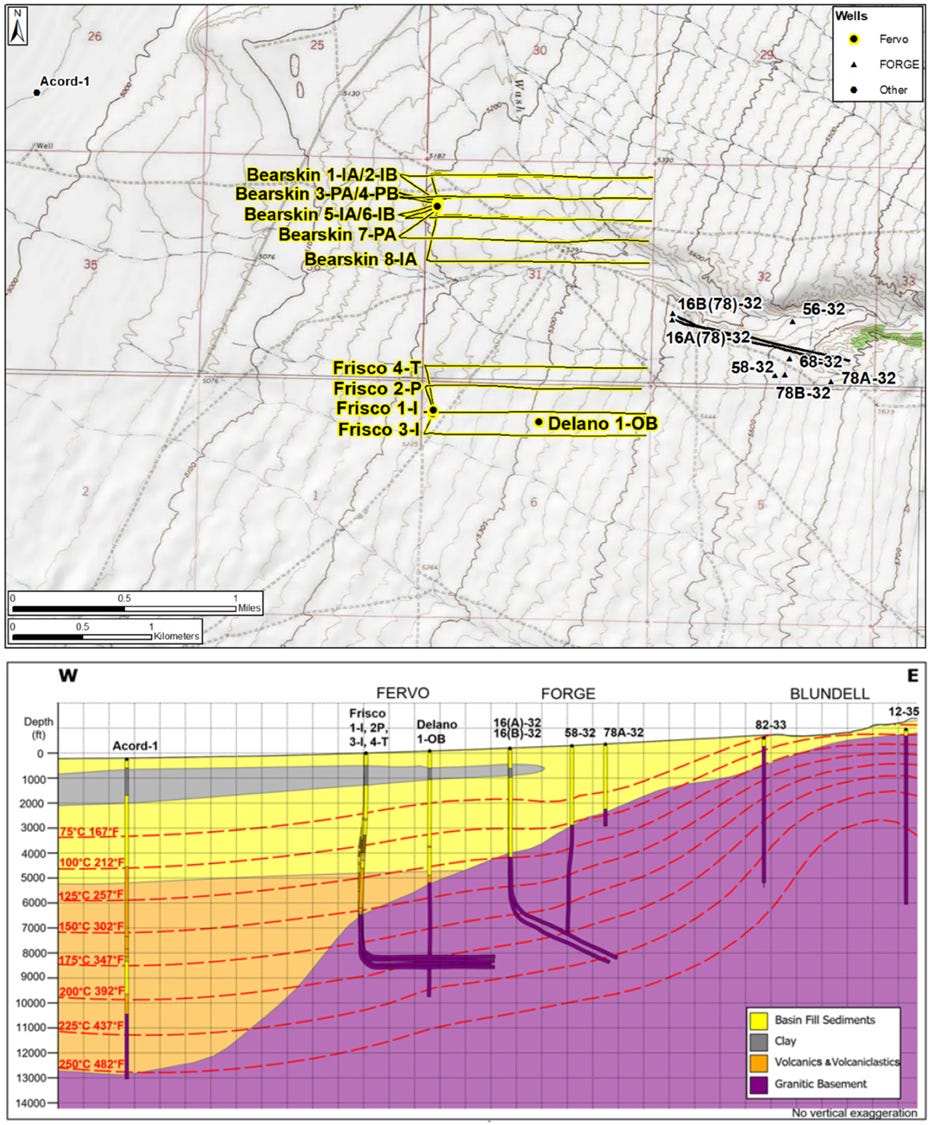
Flow tests so far look quite positive, although it’s expected that the geothermal temperature will drop over time. That’s because this is a heat mining operation — the rock slowly cools as you extract its energy. And like any mine, you need to expand over time, drilling and fracking more wells, to maintain your power output.
Anyway, what’s relevant for supercritical geothermal is that Fervo Energy seem to have made the stimulation of impermeable rock into a somewhat reliable and cost-effective process, which is a huge plus from an investor’s perspective.
This brings us to a revised model of supercritical geothermal extraction and something approximating a plausible theory of operation if the deep permeability hypothesis doesn’t pan out. It is a concept that scientists from Iceland proposed at last year’s Stanford Geothermal Workshop, and it has the added benefit of circumventing the extreme corrosiveness of produced supercritical fluids.

In this operation, you would inject cold water into your deep superhot zone. Initially, the water enters the rock, becomes heated and rises to your shallow wells. You collect heat from the rock along the way. And this sounds like quite a good idea for Iceland wells in superhot basalt that are permeable at supercritical conditions.
For the quartzofeldspathic rocks — granites, rhyolite-greywacke4 — you’ll need to give that injected water a helping hand if it turns out to be ductile and impermeable. By pushing the water down the well at very high pressure you can create cracks in the rock that weren’t there before and let the water take these pathways. You might need long horizontal wells to get enough of these hydraulic fractures in. This is the Fervo Energy approach, although you’d likely need some adjustments to accommodate the hotter, more ductile rock.

Once injected, I guess you’d try to collect the heated water from wells higher up in the geothermal system. There are some open questions about how long and how much of that water would migrate back to shallower depths (a fraction of it might just go downward given that cold water is heavier than hot). It’s something that can be modelled5, but a pilot borehole is really the only way to know for sure.
But, as a heat mining operation, it’s size ultimately depends on water input. If you want more energy, you need to inject more water to sweep more heat from more rock. If your aspiration is 2000 MW, then we’re talking something like a 85 million cubic meters of water injected each year6. It sounds like a lot — it is a lot, about half Auckland’s annual water consumption — however, you’d almost certainly be recycling most of this water in a closed loop. But, if you are going to be circulating a lot of water to mine your supercritical heat, then this does raise the issue of induced earthquakes.
Large volumes of injection can trigger earthquakes
Injecting water into rock can have unintended consequences. High fluid pressure tends to destabilize faults, in the event the water manages to find its way onto one. Not a problem if you know where the faults are because you can just take care not to inject there. However, most faults can’t be seen from the surface so you don’t generally know about them until they start lighting up with earthquakes.
This is only really an issue if the earthquakes get large enough. So, what should we expect? Past experience tells us the vast majority of induced earthquakes are small enough that they’d never be felt by someone at the surface. Only a small fraction will be large enough to experience, usually when they get above magnitude 3.
A handful of induced earthquakes are large enough to cause damage. Some famous cases include a magnitude 3.4 in Basel, Switzerland and a magnitude 5.5 in Pohang, South Korea. Both were caused by stimulation of low-permeability geothermal wells in granite. Both resulted in those geothermal projects being cancelled and the investment lost. So, anyway, you’ll want to be careful and have a plan to stop if things are looking seismically suspicious.
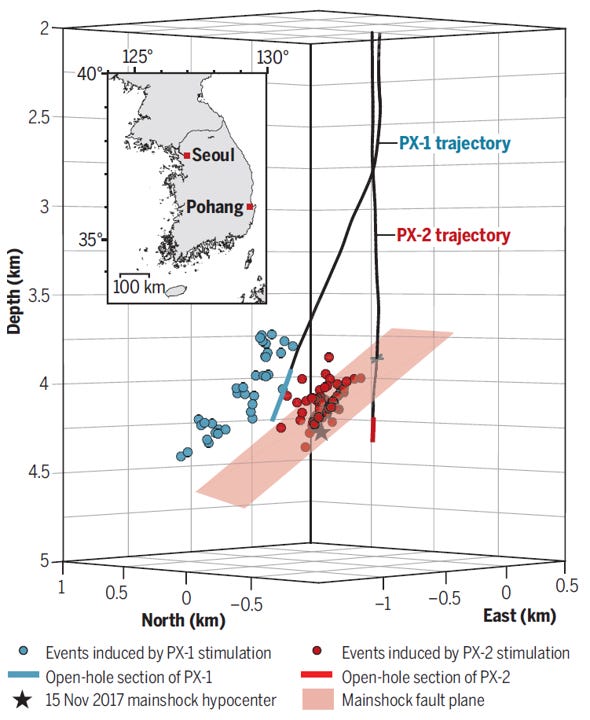
How many earthquakes?
There is a way to estimate how many earthquakes you might expect for a given injection operation. You’d want to distinguish between the likely two phases of any supercritical system: the initial high-pressure hydraulic fracturing to create permeability (if that’s needed) and the later lower-pressure circulation of water for heat mining. I’ll just deal with the latter here, as its applicable to both deep injection approaches (with and without fracking).
For this calculation, I’ve used the Seismogenic Index, which is a concept from Serge Shapiro and colleagues. In a series of papers over the last 15 years they have shown that the Earth’s crust can act like a bit of a currency exchange — humans put water in and the rock gives you back earthquakes. The exchange rate is the seismogenic index: “you give me 1 million cubic meters of water and I’ll give you X earthquakes” where X could be anything between 1 or 1000.
The higher number would correspond to a seismogenic index of about -1, typical of stimulations in an enhanced geothermal system but unlikely for lower-pressure flow operations. Normal geothermal systems operate with seismogenic indices between -3 and -47. If the same were true on average for supercritical geothermal, then for 2000 MW you’d expect to see a magnitude 4 or 5 earthquake each year, and perhaps a 5.5 or 6.5 over the 35 year project life8. At the high end, you do need to ask whether such earthquakes are possible on the faults we have in the central North Island. The 1987 Edgecumbe earthquake was a magnitude 6.5, so it does suggest large events are not outside the realm of possibility.
Some caveats. These calculations are hard to do with a lot of certainty. Are there large enough faults at the site to bear out the earthquake risk? Are stress conditions conducive to these levels of seismicity, particularly where ductility may be eroding any tendency9 to stress criticality? Could you adequately contain fluid migration to limit seismicity on major faults? Given these unknowns, I’d say the best use of the numbers I’m estimating here would be to convince you that induced earthquake risk deserves serious scrutiny. And it may be that any major deployment of supercritical geothermal would need to find a way to coexist with moderate magnitude seismicity.
Conclusion
Supercritical geothermal does sound like a great idea, and there’s a lot of scientific value in drilling deep holes in the Earth’s crust. I’m all on board with that.
But an economically viable operation is a different matter. First, I’m not convinced we have the best rocks to do this with, but maybe we do have an advantage with our rifting rate. But, if you absolutely had to do it in NZ, then you’ll need to have a plan for creating permeability in the event that these expensive wells don’t flow.
Large-scale multi-stage hydraulic fracturing is really the only present-day technology that could do that for you. You’ll want to push water and mined heat upward, although you may need to accept lateral and downward losses, and some associated seismic risks. Prepare to be regularly drilling and renewing the wellfield to combat declines, and have a plan for mitigating moderate magnitude seismicity if containment cannot be achieved.
The stored heat calculation for energy E is given below (numbers from this report):
where ρ is rock density (2700 kg/m3), c is specific heat (1.3 kJ/kg/K), A is geothermal area (128 km2), h is thickness of the supercritical reservoir (2.5 km), Tavg is its average temperature (437.5°C), Tref is the temperature it is cooled to (200°C), ηrec is the recovery efficiency (4.6%) and ηrec is the conversion efficiency in the power plant (30%). If you substitute those numbers into the formula, assume the heat is extracted over a 35 year lifetime, then you get about 30 000 GWh/year.
Also worth a mention, these permeability experiments use strain rates of 10-6 s-1, which is about 100 million times faster than the ‘fast’ spreading crust in NZ. That’s not a criticism, because you certainly can’t wait 100 million years to run an experiment. But it does add some challenges to interpreting whether such fracture permeability would be retained over geological time.
Or otherwise stimulating through low-pressure shear failure or acid injection or cold thermal stimulation.
Of course, there are other types of rock underground as well. Some basalt, and bits of andesite and dacite. But a large part of the TVZ basement is likely greywacke intruded with rhyolite, which is why I’ve mainly focused on that type.
Speaking of modelling, here’s a good paper that tries to look at the problem of deep permeability loss with depth and temperature. The authors explore a range of conditions with their preferred model finding 450°C at 8.5 km depth and a horizontal permeability of 2.5x10-17 m2 (vertical 10x higher). That’s pretty low and it’s not clear if the authors think this supports a viable model of an exploitable supercritical geothermal reservoir without further stimulation.
To estimate water requirements, I considered that each parcel of water delivers a certain amount of energy as it passes through a power station. I assumed the same 30% efficiency used in the stored heat calculation above, along with an energy extraction of about 2500 kJ from each kg of hot water. This amounts to a requirement of around 85 million tonnes of water each year to meet the target of 2000 MW of power production (allowing for the 30% conversion efficiency). Assuming the water you collect has to at some point be injected into the base of the system to mine the heat, then that same water occupies a volume of 85 million cubic meters, converting with a cold water density of about 1000 kg/m3.
Geysers, California: NM>2.5=1380 for V=800 million m3; Larderello, Italy: NM>2.5=10.5 for V=15.5 million m3; Rotokawa, NZ: NM>2.5=53.7 for V=54 million m3; Salton Sea, California: NM>2.5=178 for V=200 million m3. Calculation converts from reported to reference magnitude of 2.5 for comparison, truncating the calculation at the date of the largest event.
The seismogenic index calculation is given in Eq. (5) of Shapiro et al. (2013)
where N is the number of induced earthquakes caused by an injected volume V (m3), b is the Gutenberg-Richter b-value (usually close to 1.0) and M is the magnitude of earthquake you’re interested in. Σ is the seismogenic index.
Setting N to 1, and therefore the lefthand side to zero, means we can interpret M roughly as an expected magnitude for a given injection volume. For instance, with V equal to 85 million m3 and Σ on the low end of -4, we get an expected largest earthquake of magnitude 3.9 each year. Alternatively, a 35-year lifetime assessment would use V = 3 billion m3. If Σ were instead on the higher side of -3, that would amount to M of 6.5.
Ductility and fault reactivation are not necessarily incompatible (although slip may be aseismic). The primary concern here would be loss of injected fluid away from the ductile halo of the magma body into the brittle crust where critical faults may be present. Vertical migration would also take the fluids from ductile to brittle conditions.




